新冀教版 八年级下册Lesson 2:It’s getting warmer!
冀教版八年级下册Lesson 2 It’s Getting Warmer教案
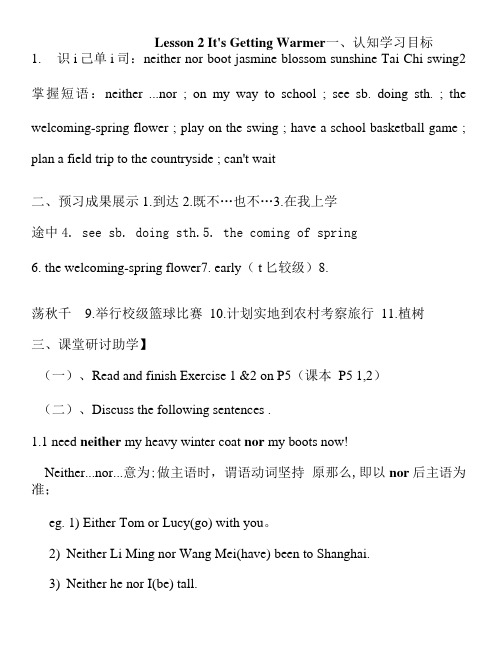
Lesson 2 It's Getting Warmer一、认知学习目标1.识i己单i司:neither nor boot jasmine blossom sunshine Tai Chi swing2 掌握短语:neither ...nor ; on my way to school ; see sb. doing sth. ; the welcoming-spring flower ; play on the swing ; have a school basketball game ; plan a field trip to the countryside ; can't wait二、预习成果展示1.到达2.既不…也不…3.在我上学途中4. see sb. doing sth.5. the coming of spring6. the welcoming-spring flower7. early( t匕较级)8.荡秋千9.举行校级篮球比赛10.计划实地到农村考察旅行11.植树三、课堂研讨助学】(一)、Read and finish Exercise 1 &2 on P5(课本P5 1,2)(二)、Discuss the following sentences .1.1 need neither my heavy winter coat nor my boots now!Neither...nor...意为;做主语时,谓语动词坚持原那么,即以nor后主语为准;eg. 1) Either Tom or Lucy(go) with you。
2)Neither Li Ming nor Wang Mei(have) been to Shanghai.3)Neither he nor I(be) tall.2.Spring has arrived in Shijiazhuang. 表示“到达”的有 //.eg.The temperature15 °C this morning. A.got B.arrived C.reachedD.is3.1 saw some winter jasmine blossoming.see sb. doing sth.意为,表示; see sb. do sth.意为,表示Eg: 1. When I walked past the park.I saw some old people(do) Taiji.Do you see someone (play) on the playground?(三)、完成课本第5页的Exercise 3.四、当堂训练检测1.Jim Kate good at Chinese, but they are good at English.A. Either ; or ; isB. Neither ; nor ; isC. Both ; and ; areD. Not only ; but also ; isWhen the spring, the weather can get warmer.A. getsB. arrivesC. reachesD.arrives inI see lots of people(exercise) on the square every morning.2.The weather in summer is getting(hot).3.The sun(rise) earlier in the morningIn spring, everyone enjoys(plant) trees.4.Neither your father nor you(like) playing on the swings.5.Some students like singing.(others / the others)like dancing.。
八下英语冀教版第2课翻译

八下英语冀教版第2课翻译八年级下英语冀教版第2课翻译:Lesson2:It's Getting Warming!天气变暖了!课文英汉对照 THINKABOUTIT:想一想!When does spring begin?When does the weather become wamer in your hometown?春天什么时候开始?你的家乡何时天气变暖?Whatis the weather like in spring?春天天气怎么样?What is the tmperature of the air near lightning?闪电附近空气的温度是多少?图片译文:What's the date today ? It's March twenty-first ! It is spring now 今天是几月几日?是3月21日。
现在是春天了 You can write dates with numbers, too. How can you write March twenty-first? That's right!你也可以用数字写日期。
你怎样写3月21日呢?对了, March 2lst or March 21.March 2lst 或March 21 ·How many hours of daylight are there on March 21st 在3月21日,白天有多少个小时?There are twelve hours of daylight. The sun rises at about six o'clock in the morning and it sets at about six o'clock in the evening.白天有12个小时,太阳大约在早上6点升起,大约在晚上6点落下。
Do you see two words you already know in " daylight " ? That's right ! " Day " and " light " . When is it daylight ? When the sun is up !你在"daylight"中看出已经认识的两个单词了吗?对了,是"day"and"light",daylight是什么时候?当太阳升起的时候!·What is spring weather like?春天天气怎么样?In spring, the weather becomes warmer.在春天,天气变暖和了The temperature goes up! In early spring, it sometimes snows. But the snow melts quickly in the warm sun 气温上升!在初春,天有时下雪。
八年级英语下册教学(冀教版,河北专版)Lesson2It'sGettingWarmer!优秀教学案例
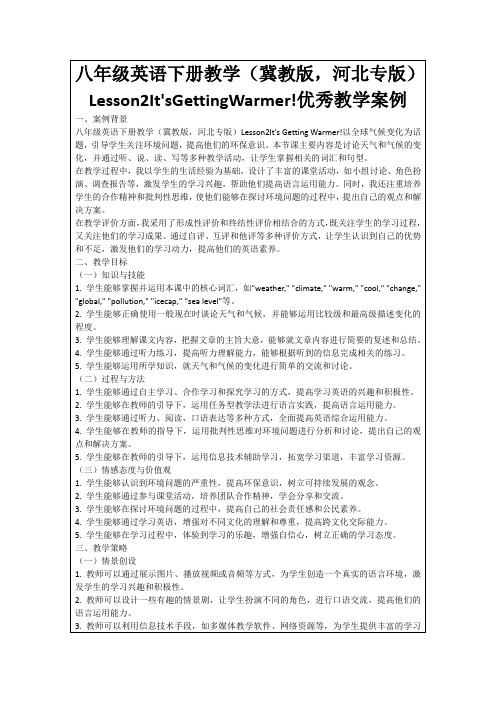
4.反思与评价的培养:教师鼓励学生在学习过程中进行自我反思,发现自己的优势和不足,制定相应的学习策略。同时,教师还组织学生进行互评和他评,让学生从不同的角度了解自己的表现,提高他们的自我评价能力和批判性思维。
4.教师可以对学生的学习过程和成果进行记录和总结,为学生提供全面、客观的评价,促进他们的全面发展。
四、教学内容与过程
(一)导入新课
1.教师可以通过展示一些与环境变化相关的图片或视频,如全球变暖、海平面上升等,引起学生的兴趣和关注。
2.教师可以提出一些引导性问题,如“你们有没有注意到天气和气候的变化?”、“你们认为是什么原因导致了这些变化?”等,激发学生思考和讨论。
(三)情感态度与价值观
1.学生能够认识到环境问题的严重性,提高环保意识,树立可持续发展的观念。
2.学生能够通过参与课堂活动,培养团队合作精神,学会分享和交流。
3.学生能够在探讨环境问题的过程中,提高自己的社会责任感和公民素养。
4.学生能够通过学习英语,增强对不同文化的理解和尊重,提高跨文化交际能力。
3.教师可以对学生的表现进行评价和反馈,鼓励他们继续努力。
(五)作业小结
1.教师可以布置一些与环境变化相关的作业,如写一篇关于环保的文章、做一个关于气候变化的调查报告等,让学生进行深入研究和思考。
2.教师可以要求学生在作业中运用所学知识和表达方式,提高他们的语言运用能力。
3.教师可以对学生的作业进行批改和评价,及时给予反馈,指导学生的学习。
3.学生能够理解课文内容,把握文章的主旨大意,能够就文章内容进行简要的复述和总结。
新冀教版八年级英语下册Lesson 2 It’s getting warmer精品课件
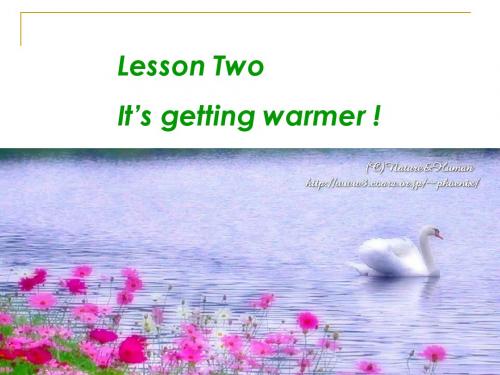
5. noise 可数n, “噪音” make a noise 发出声响,吵闹 voice “人的嗓音”组卷网 sound “指人听到的任何声音”。
rose 1.The sun ______(rise ) at six this morning . hotter 2.Did you know lightning is sometime________(hot) than the sun .
make 6.Thunders ___ _____ (make) a loud noise . showers 7.In April ,rain _________(shower) begin .
2.on a school day 在上学的日子 辨析:on, in 与at (1) on 表示某日或特定某日中的一段时间。 eg: on Thursday morning on July 10,1997 on a cold winter night (2) in 表示一日中的上午、下午、晚上或周、月、 季节,用in eg: in the afternoon in January in summer in +一段时间 “在…之后”
became 3.When he grew up ,he ________(become) a doctor.
4.What season ________(come) before spring ? comes
5.The snow _________________(not melt) easily in doesn’t melt winter .
1.---What’s the date today? 今天是几月 几号? ---It’s ... ... 描述具体的日期即可用基数词,也可用 序数词。 eg: --- What’s the date the day after tomorrow?(后天) ---It’s January 1/1st. 注:在询问具体日期时,一般不用将来时, 而用一般现在时。
Lesson2It'sGettingWarmer教案2023-2024学年冀教版八年级英语下册

科目
授课时间节次
--年—月—日(星期——)第—节
指导教师
授课班级、授课课时
授课题目
(包括ቤተ መጻሕፍቲ ባይዱ材及章节名称)
Lesson 2 It's Getting Warmer教案2023-2024学年冀教版八年级英语下册
-分享和展示:学生分组展示他们完成的气候变化项目,其他学生和教师提供反馈和建议。
3.确定教学媒体和资源的使用:
- PPT:教师使用PPT呈现本节课的主要内容和知识点,配以图片、图表等视觉辅助材料,帮助学生更好地理解和记忆。
-视频:教师播放一些关于气候变化的短视频,为学生提供真实的信息和案例,增强学生的直观感受。
课堂上,我尝试了多种教学方法,如讲授、讨论、案例研究等,希望能够激发学生的学习兴趣和参与度。我发现,学生们对于气候变化这个话题非常感兴趣,他们在讨论和分析案例时表现出了很高的积极性和主动性。这让我感到欣慰,也让我意识到,选择贴近学生生活实际的话题,能够有效提高他们的学习积极性。
同时,我也注意到了一些问题。例如,在小组讨论环节,我发现有些学生参与度不高,讨论成果也不够深入。这让我意识到,如何在小组合作中提高每个学生的参与度,如何引导他们进行深入思考,是我需要进一步研究和探索的问题。
例题四:请用英语描述以下气候变化的挑战。
1.答案:Climate change presents many challenges to our planet and society. One challenge is the increasing frequency and intensity of extreme weather events, such as hurricanes, floods, and wildfires, which can cause significant damage and loss of life. Another challenge is the loss of biodiversity, as many species are unable to adapt to the changing climate and are facing extinction. Additionally, climate change threatens food security, water availability, and human health, as well as exacerbating existing social and economic inequalities.
八下英语第二课翻译冀教版
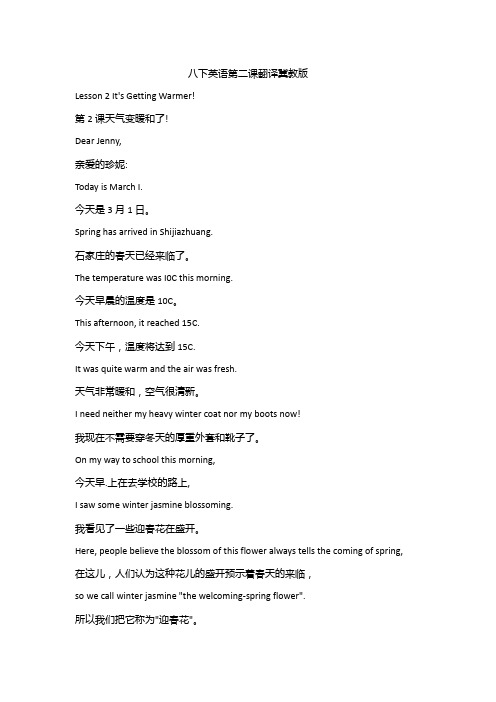
八下英语第二课翻译冀教版Lesson 2 It's Getting Warmer!第2课天气变暖和了!Dear Jenny,亲爱的珍妮:Today is March I.今天是3月1日。
Spring has arrived in Shijiazhuang.石家庄的春天已经来临了。
The temperature was I0C this morning.今天早晨的温度是10C。
This afternoon, it reached 15C.今天下午,温度将达到15C.It was quite warm and the air was fresh.天气非常暖和,空气很清新。
I need neither my heavy winter coat nor my boots now!我现在不需要穿冬天的厚重外套和靴子了。
On my way to school this morning,今天早.上在去学校的路上,I saw some winter jasmine blossoming.我看见了一些迎春花在盛开。
Here, people believe the blossom of this flower always tells the coming of spring, 在这儿,人们认为这种花儿的盛开预示着春天的来临,so we call winter jasmine "the welcoming-spring flower".所以我们把它称为"迎春花"。
The days are getting longer and the sun rises earlier in the morning.白天变得越来越长,太阳越来越早的升起。
The warm sunshine feels good after the cold winter days.在冬季过后,温暖的阳光让人感觉很舒服。
冀教英语八下《Lesson 2 It’s Getting Warmer》(共17张PPT).

(T )
知识点讲解
★get, become, turn 3个“变”的用法 get 多用于口语,表示一种变化过程,强调
“渐渐变得……”,后+adj.比较级 become中性词,用于意义好、坏两方面的变
化都可以,多指身份、职位等的变化,强调 变化的过程已经完成,后+n./adj. turn 指在颜色和性质等方面与以前完全不同, 强调变化的结果
Think About It
• How many seasons during a year? • Which season do you like? • Why?
1.They are all beautiful, aren’t they? 2.Which is the first season?
Of course, the answer is Spring!!!
Lesson 2:
It's Getting Warmer
New Words:
温暖的(adj.)
warm
开花 (v.) 花朵(n.) blossom
阳光(n.)
sunshine
一.短语理解
1. neither...nor... 2. winter jasmine
start to come out in spring.
★★★ 知识点讲解:
neither
conj. pron. adj. adv.
知识点讲解
• 1. conj. 既不…也不…;两者都不… • 常用结构:neither…nor… • 反义短语:both…and…
或:not only…but also… • 可连接平行的两个主语、谓语、宾语、表语
“既不……也不……” “迎春花”
八年级英语下册教学(冀教版,河北专版)Lesson2It'sGettingWarmer!教学设计
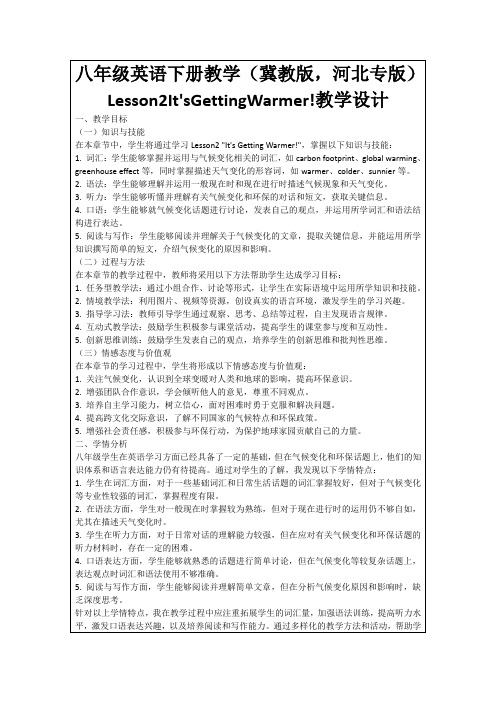
2.在语法方面,学生对一般现在时掌握较为熟练,但对于现在进行时的运用仍不够自如,尤其在描述天气变化时。
3.学生在听力方面,对于日常对话的理解能力较强,但在应对有关气候变化和环保话题的听力材料时,存在一定的困难。
3.教师强调气候变化对人类和地球的重要性,呼吁学生关注环保,为保护地球家园贡献自己的力量。
4.布置课后作业,要求学生运用所学知识,撰写一篇关于气候变化的短文,巩固所学成果。
五、作业布置
为了巩固本节课的学习成果,确保学生对气候变化话题的理解和运用能力得到提升,特布置以下作业:
1.词汇积累:请学生整理本节课所学的气候变化相关词汇,并查找至少三个额外的相关词汇,要求写出单词、词性、中文意思,并造一个句子展示其用法。
2.学生分享自己的观察和想法,教师适时引导,将话题引入到本课的主题:“It's Getting Warmer!”。
3.教师播放一段关于全球变暖的短视频,让学生了解全球变暖对地球和人类生活的影响,为后续学习做好铺垫。
(二)讲授新知,500字
1.教师带领学生学习本课的词汇,如carbon footprint、global warming、greenhouse effect等,通过例句、图片等形式帮助学生理解和记忆。
三、教学重难点和教学设想
(一)教学重难点
1.词汇:气候变化相关的专业词汇,如carbon footprint、global warming、greenhouse effect等,以及描述天气变化的形容词,如warmer、colder、sunnier等。
2.语法:现在进行时在描述气候变化和天气状况中的应用。
- 1、下载文档前请自行甄别文档内容的完整性,平台不提供额外的编辑、内容补充、找答案等附加服务。
- 2、"仅部分预览"的文档,不可在线预览部分如存在完整性等问题,可反馈申请退款(可完整预览的文档不适用该条件!)。
- 3、如文档侵犯您的权益,请联系客服反馈,我们会尽快为您处理(人工客服工作时间:9:00-18:30)。
(总第课时)Lesson 2:It’s getting warmer!
授课人:时间:
学习目标:
1. 掌握的词汇及短语:. daylight ,ligntning fansinating
2. 句式:询问天气的问及答语:What’s the date today?
重难点:On的用法,合成词,描绘初春
课前预习:重点语句分析
It’s getting warmer.
天变得更暖和了。
get是系动词,后面常加形容词作表语
课上讲解:
1.Spring has arrived in Shijiazhuang.
arrive 是不及物动词,意为“到达”,后必须加介词才能接宾语.arrive at 加小地点.arrive in 加大地点.
I arrived in Xi'an yesterday.
I arrived at the small village yesterday.
get 后加to 然后加宾语.
When we got to the park,it began to rain. reach 后直接加宾语. I reached Xi'an yesterday.
注意:后接地点副词(there,here,home )时,三者都不加任何介词.
We were tired when we arrived/reached/got home. We got (arrived) here last night.
精讲释疑:
1.I need neither my heavy winter coat nor my boots now .
neither---nor ---是并列连词,“既不---也不---
在句中可连接两个并列成分。
当连接两个主语时,谓语要与邻近的主语形式保持一致,且用肯定形式。
Neither he nor I am a doctor .
Neither Jim nor his parents have been to beijing.
both---and---两者都---;either---or---或者---或者---
Both my father and my mother are teachers.
I have only one ticket, either you or Lily can go to the concert.
Either you or he has to go = Either he or you have to go .
Neither you nor I am right .= Neither I nor you are right . 2.The day are getting longer and the sun rises earlier in the morning .
get作系动词,“变得”,后接名词、形容词的原级或比较级作表语,多用于进行时态。
The day are getting longer and longer .She is getting an old woman.
3.Every morning, I see lots of people exercising in the park.
see sb doing sth 看见某人正在做某事,强调读作正在发生。
see sb do sth 看见某人做某事,强调动作发生的过程或经常看到动作发生。
I saw him cleaning the room.
I often saw him play basketball.
4.exersise作动词,锻炼;操练;训练。
Uncle Wang exercises every morning.
作名词,表示“锻炼;运动”讲时,是不可数名词;当表示“练
习,习题,操练”讲时,是可数名词。
常用短语take exercise“做练习”。
We must take more exercise every day.
The students do eye exercises twice a day .
5.Some practice Tai Chi.Others sing and dance.
Some---others---一些---另一些---
拓展延伸:
1. They arrived Shanghai a cold morning.
A.in ;in
B. in ;on
C. at; on
D. at; in
2.Let’s go Kunming for vacation. It’s too hot
too cold there.
A.either;or
B. neither ;nor
C. both;and
D.not only;but also
3.When I walked past the park ,I saw some old people Chinese Taiji.
A.do
B. did
C. doing
D.are doing
4.To keep healthy, many people every day .
A. take a shower
B. take pride
C. take a look
D. take exercise
学后反思:。
